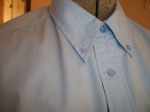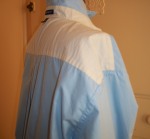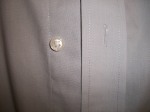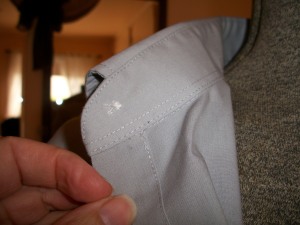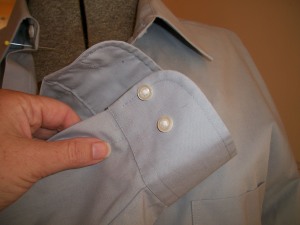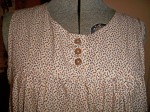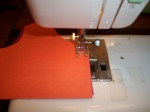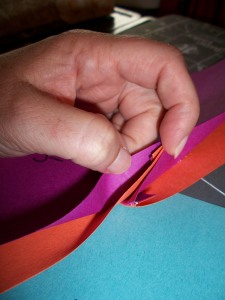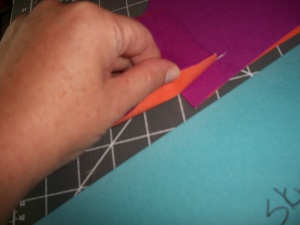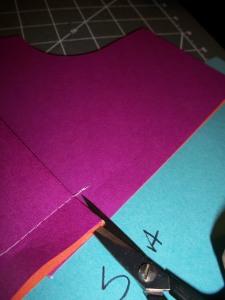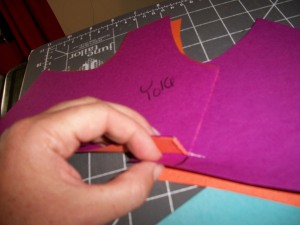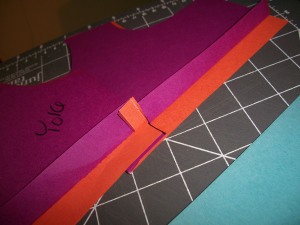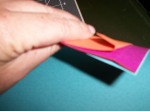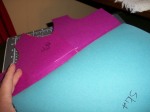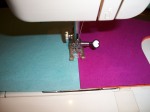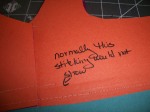 I know a lot of us are going to be receiving jeans as Christmas presents and for many of us those jeans are going to be too long. And not just a little. For us to even walk about something will have to be done.
I know a lot of us are going to be receiving jeans as Christmas presents and for many of us those jeans are going to be too long. And not just a little. For us to even walk about something will have to be done.
If you frequently buy super expensive jeans, you know the ones that cost 3 digits $$$– get thee to a proper seamstress. A shop will have thread that matches your jeans exactly and you won’t be sweating a possible mess up on a luxury item.
But for those of us who buy jeans of a more practical variety, and depending on your frequency of wear, a basic sewing machine may pay you back in alterations bills. For those with even a mild interest in sewing jeans hemming is well within reach. If this is the only sewing project you ever learn you will be doing yourself a huge favor.
What you will need
A basic sewing machine and working familiarity with it. Meaning you know how to thread the machine and wind the bobbin. You understand that stitch lengths go from very short to very long. You have successfully worked with your tension to create a passable line of stitching. You can use the stitch guides on the throat plate so your stitches are straight.
Thread that matches, at least somewhat, the topstitching on the jeans. Special jeans topstitching thread is available, but for most projects, I use regular thread in the light brown – rust color variance.
Sewing machine needles that will cut through tough denim. Schmetz makes special needles just for denim n various sizes. In a pinch I have also used embroidery or universal needles at the 90/14 size.
A bunch of jeans that you don’t mind making mistakes on. The best source for these is a thrift store. Trust me, however bad you feel about screwing up thrift store jeans, you will feel loads worse ruining your $75.00 pair. Twenty dollars of jeans used for practice may save you tons in alterations costs later on.
These are the steps I take to hem my jeans. I have done it a gazillion times. It does work with a little practice.
And now for you adventurous souls, let’s be on our way.
1.) The jeans are too long for my taste. I am using a pair of shoes with a middling heel. I don’t mind if my jeans are a little long for flats, but I abhor too short jeans with heels.
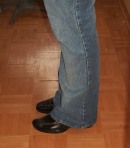
2.) Fold up the hem at the desired length. This may take a few tries. I err on the side of overlong because I have mistakenly hemmed too short in the past.

3.) Pin the hem so you don’t lose it when you take the jeans off.

4.) Measure your desired hemline. The fold is where you want your new hem. The turned up bit is what you have to work with to make your hem. My jean hems are usually ½ inch. I need two of those ½ inch widths so I can complete the folded over hem (1/2 inch on the inside of the fold, ½ inch on the outside). So you would measure one inch or so from the fold. Any more is excess. (You can see that my measurement is 1 ¼ inch. I went ahead and kept that extra ¼ inch.)
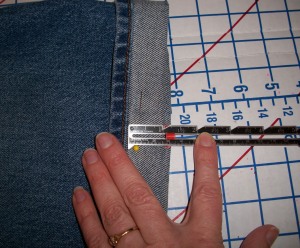
5.) Cut away your excess. On these I decided to just cut away the previous hem.

6.) Choose your thread color and sewing machine needles. I am using Coats and Clark general sewing thread in a color that matches the jeans topstitching. I am also using standard Universal 90/14 Schmetz needles as I know from past experience that they will work through denim, at least for the short time I will need them sewing just a hem.

7.) Choose a long stitch length. The illustration on the machine stitch length dial (marked C pointing up) shows the length you are aiming for. The reason you are choosing a longer stitch length than normal is because that thick jean fabric is going to eat up your thread. Thicker fabric has more length of thread sitting within the fabric making for a shorter stitch on top. This is all hard to explain. But too short a stitch on jeans will drive you crazy.

8.) Use your freearm if you have one.

To access your freearm see if there is a section of your sewing machine that can be pulled away to make a smaller bed. That way you can get the short circumference of your jeans around your machine making them easier to sew.
9.) 3/8 – ½ inch into the hemline make a staystitch line. There are no folds on my jeans yet. Just a line of stitching along the bottom bare edge.
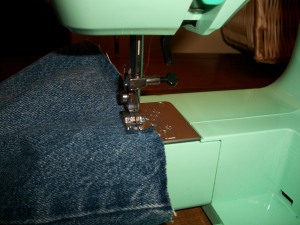
10.) Cut away any bulky seams best you can under the staystitch line.
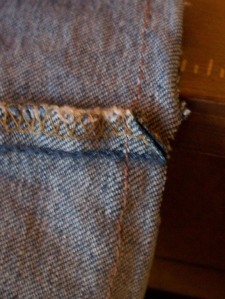
11.) Turn your jeans inside out. Many times I do my topstitching from the outside where I can see, but on jeans I use the inside. Using your staystitch as an arm to fold over upon turn your jeans hem under the machine as you sew.

!!!! POTENTIAL PROBLEM!!!! When your reach the bulky side seams, slow down. Turn the needle by the handwheel if you have to. You may also have to push and pull the fabric along a bit. If you hear your machine sounding harsher, or like it is straining, STOP. Gently start again with the handwheel and kick in the pedal when you are over the worst of the hump. If you have a jam, don’t force it. Pull out the jeans and cut the thread. If you can’t get over the side seams you do have the option of sewing up to that seam, skipping the bulky portion, and beginning again on the other side. I don’t often use this method, but some denim can be incredibly thick and unworkable.
12.) Iron your new hemline down for crispness.

Now check in the mirror.
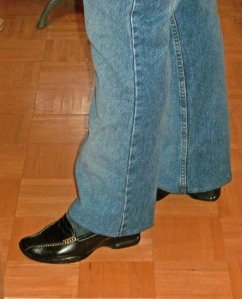
These jeans are now at an acceptable hem point for me. Long enough for a slight heel without dragging the ground.
At this point, ask yourself some questions.
Is this the length that I want?
Is my topstitching compatible with the overall look of the jeans?
If the jeans look wonky, is that because of my sewing technique, or is it something funny about the length.
If the sewing details are off, take a practice pair of jeans and just keep cutting hems up the pants leg until you have the technique down. For example, each person has to work out their own way of getting past that huge bulky seam. If your stitching is uneven or comes loose, practice technique.
If you jeans are the wrong length, are they too short or too long? My tendency is toward such exactitude that I get the hemline too short. Standing still the pants look fine but they ride up a bit with movement raising the hemline to undesirable heights. Knowing my proclivities I often add an inch to my pinned hem. You may have the opposite tendency of allowing too much hem. The only way to know your own tendencies is to hem. Find several pair of dirt cheap thrift store jeans and practice.
At first it seems like a lot of work, but after a few practice pairs you can successfully hem a pair of jeans within twenty minutes. What used to be a chore is now one of the easiest sewing projects I do, in less time than it would take me to drive to the alterations shop. After about six pairs you will be fearless even in the face of three-digit-dollar jeans!
Next Post: Tuesday, December 28, 2010: I am taking a few days off for the Holidays to visit family. I’m sure after all of that food and family I will be eager to get back to my machine. Looking forward to showing you what new things I have done.

 I remember associating these with the matrons of my youth, who often wore unalluring housedresses and industrial strength bras. That’s why I glance over them on the notions shelf. I assumed that anyone who might need one of these little numbers was definitely not in the childbearing stage of life.
I remember associating these with the matrons of my youth, who often wore unalluring housedresses and industrial strength bras. That’s why I glance over them on the notions shelf. I assumed that anyone who might need one of these little numbers was definitely not in the childbearing stage of life.
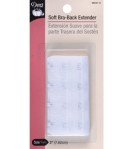




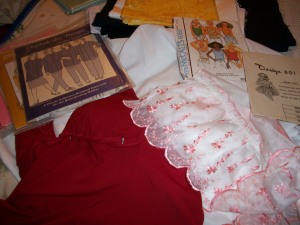


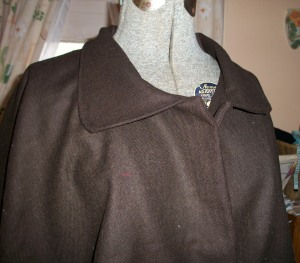



















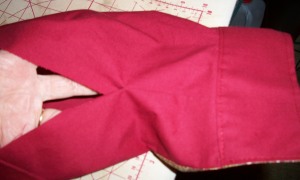


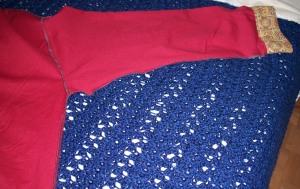










 !!!!!!!!!
!!!!!!!!!